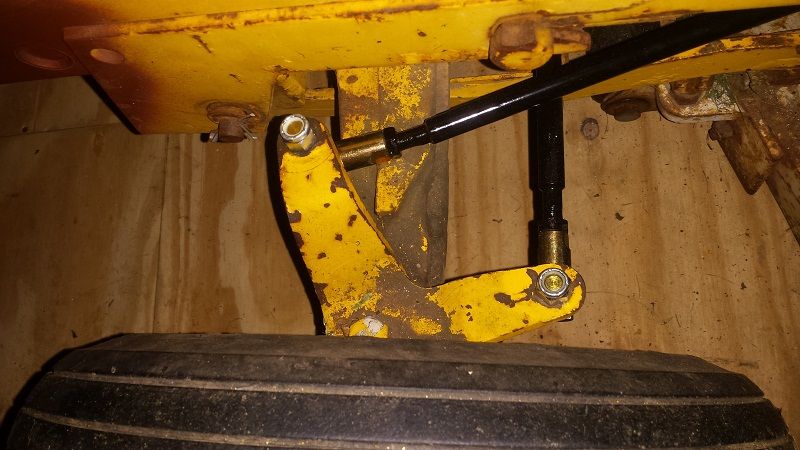
 |
PLEASE PATRONIZE OUR SPONSORS!






|
|||||||
 |
|
|
Thread Tools | Display Modes |
|
#31
|
|||
|
|||
|
Quote:
My bigger questions are of cost vs. benefit and if the zerk is really an advantage over a tie rod when you consider the heim joint is completely unsealed. |
|
#32
|
||||
|
||||
|
The CC end is steel ball in steel socket.
No grease, no oil, no bronze, no slippery plastic. It does not wipe the bearing surface clean when it moves. It relies on the rubber sleeve/seal not drying out, splitting and falling off to keep abrasives out. The Heim style can be had with oil impregnated bronze bearing surface. Or a PTFE liner instead. The HEIM joint wipes the bearing surfaces clean when it moves. If you use a non-stud type HEIM joint directly bolted with a bolt in the eye, then the movement will be restricted. Use the stud style HEIM joint. |
|
#33
|
||||
|
||||
|
Quote:
[IMG]  [/IMG] [/IMG]
__________________
"We don’t stop playing because we grow old, we grow old because we stop playing." 
|
|
#34
|
||||
|
||||
|
Sorry for the questions but which lock nut are you speaking of? It looks like the lock nuts are up against the ball joints? So how much thread is in that ball joint on the drag line that is bent? It looks like it is really not on that deep?
|
|
#35
|
||||
|
||||
|
The stud on the original joint measured 7/8" on the new ones it is 5/8". The stud is almost to the top of the nut when it is tightened. The nut you are referring to is the jam nut...the nylon lock nut is the one holding the assy to the steering knuckle. and at the time I took this picture it wasn't tightened completely.
__________________
"We don’t stop playing because we grow old, we grow old because we stop playing." 
|
|
#36
|
||||
|
||||
|
Quote:
|
|
#37
|
|||
|
|||
|
That was my first thought, my second was that they also make grinders.
 Take a little off of the bottom of the nuts. It doesn't appear to be a direct swap anymore though. |
|
#38
|
|||
|
|||
|
I had one on my MTD built Huskee that went bad within two years, the OEM replacement has lasted 12 yrs. No change in usage.
__________________
Cub Cadet 86 Mahindra eMax 22 w/FEL Husqvarna LGT2554 John Deere GT275 '48 Ford 8N '41 Ford 9N Yerf Dog Scout CUV |
 |
|
|
Cub Cadet is a premium line of outdoor power equipment, established in 1961 as part of International Harvester. During the 1960s, IH initiated an entirely new line of lawn and garden equipment aimed at the owners rural homes with large yards and private gardens. There were a wide variety of Cub Cadet branded and after-market attachments available; including mowers, blades, snow blowers, front loaders, plows, carts, etc. Cub Cadet advertising at that time harped on their thorough testing by "boys - acknowledged by many as the world's worst destructive force!". Cub Cadets became known for their dependability and rugged construction.
MTD Products, Inc. of Cleveland, Ohio purchased the Cub Cadet brand from International Harvester in 1981. Cub Cadet was held as a wholly owned subsidiary for many years following this acquisition, which allowed them to operate independently. Recently, MTD has taken a more aggressive role and integrated Cub Cadet into its other lines of power equipment.
This website and forum are not affiliated with or sponsored by MTD Products Inc, which owns the CUB CADET trademarks. It is not an official MTD Products Inc, website, and MTD Products Inc, is not responsible for any of its content. The official MTD Products Inc, website can be found at: http://www.mtdproducts.com. The information and opinions expressed on this website are the responsibility of the website's owner and/or it's members, and do not represent the opinions of MTD Products Inc. IH, INTERNATIONAL HARVESTER are registered trademark of CNH America LLC
All material, images, and graphics from this site are the property of www.onlycubcadets.net. Any unauthorized use, reproductions, or duplications are prohibited unless solely expressed in writing.
Cub Cadet, Cub, Cadet, IH, MTD, Parts, Tractors, Tractor, International Harvester, Lawn, Garden, Lawn Mower, Kohler, garden tractor equipment, lawn garden tractors, antique garden tractors, garden tractor, PTO, parts, online, Original, 70, 71, 72, 73, 76, SO76, 80, 81, 86, 100, 102, 104, 105, 106, 107, 108,109, 122, 123, 124, 125, 126, 127, 128, 129, 147, 149, 169, 182, 282, 382, 482, 580, 582, 582 Special, 680, 682, 782, 782D, 784, 800, 805, 882, 982, 984, 986, 1000, 1015, 1100, 1105, 1110, 1200, 1250, 1282, 1450, 1512, 1604, 1605, 1606, 1610, 1615, 1620, 1650, 1710, 1711, 1712, 1806, 1810, 1811, 1812, 1912, 1914.